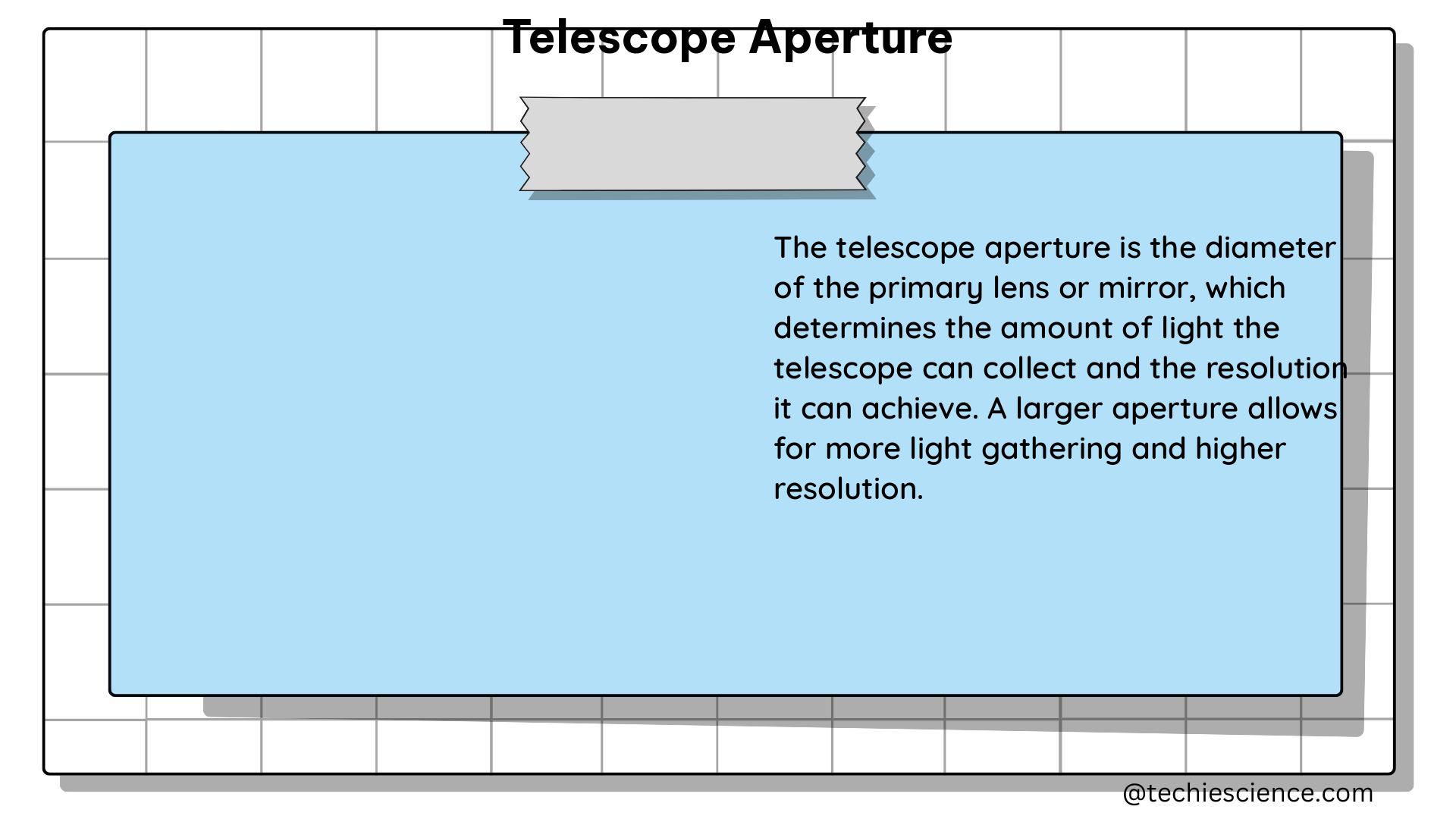The aperture of a telescope is a fundamental parameter that determines its light-gathering capability and resolution, making it a crucial factor in astronomical observations. A larger aperture allows for more light to be collected, resulting in brighter and clearer images, particularly when observing faint celestial objects.
Understanding the Airy Disk and Telescope Resolution
The impact of aperture on a telescope’s performance can be quantified using the formula for the diameter of the Airy disk, which is the central bright spot in a telescope’s image caused by diffraction:
d = 2.44 * λ / D
Where:
– d is the diameter of the Airy disk
– λ is the wavelength of light
– D is the diameter of the aperture
A smaller Airy disk corresponds to a higher resolution image, as the diffraction patterns of point sources are more closely spaced. However, a smaller Airy disk also means that less light is collected, potentially resulting in fainter images.
To illustrate the relationship between aperture and Airy disk diameter, consider the following table:
| Aperture diameter (mm) | Diameter of Airy disk (arcseconds) |
|---|---|
| 50 | 1.03 |
| 100 | 0.51 |
| 150 | 0.34 |
| 200 | 0.26 |
| 250 | 0.20 |
| 300 | 0.16 |
As the table shows, a larger aperture results in a smaller Airy disk, leading to higher resolution images. It’s important to note that the resolution of a telescope is also affected by other factors, such as atmospheric conditions and the quality of the optics.
Light-Gathering Capability and Aperture

In addition to resolution, the aperture of a telescope also affects its light-gathering capability. The amount of light collected by a telescope is directly proportional to the area of its aperture, which can be calculated using the formula:
Light-gathering area = π/4 * D^2
Where D is the diameter of the aperture.
The following table illustrates the light-gathering area for different aperture sizes:
| Aperture diameter (mm) | Light-gathering area (mm^2) | Light-gathering area (sq inches) |
|---|---|---|
| 50 | 1,963 | 3.02 |
| 100 | 7,854 | 12.09 |
| 150 | 17,671 | 27.05 |
| 200 | 31,416 | 48.59 |
| 250 | 49,087 | 75.47 |
| 300 | 70,686 | 108.93 |
As the table demonstrates, a larger aperture results in a significantly larger light-gathering area, leading to brighter and clearer images.
Factors Affecting Telescope Performance
While aperture is a crucial factor in determining a telescope’s performance, it’s important to consider other factors that can also impact its capabilities:
-
Atmospheric Conditions: The quality of the Earth’s atmosphere can significantly affect the resolution and clarity of a telescope’s images. Turbulence and distortion caused by atmospheric conditions can degrade the image quality.
-
Optical Quality: The quality of a telescope’s optics, including the primary mirror or lens, can also affect its performance. Imperfections or aberrations in the optics can introduce distortions and reduce image quality.
-
Magnification: The magnification of a telescope is determined by the ratio of the focal length of the objective lens or mirror to the focal length of the eyepiece. Higher magnification can be achieved with a larger aperture, but it’s important to balance magnification with the telescope’s light-gathering capability.
-
Observing Conditions: The location and time of observation can also impact a telescope’s performance. Light pollution, for example, can reduce the contrast and visibility of faint celestial objects, while the phase of the Moon can affect the visibility of certain features.
Practical Considerations and Applications
When choosing a telescope, it’s important to consider the specific needs and goals of the observer. For example, a larger aperture may be more suitable for deep-sky observations, while a smaller aperture may be more practical for casual stargazing or planetary observations.
Additionally, the size and weight of a telescope can be a practical consideration, as larger apertures often come with larger and heavier instruments. This can affect the portability and ease of use of the telescope.
Telescope aperture also plays a crucial role in various astronomical applications, such as:
-
Astrophotography: A larger aperture allows for the collection of more light, enabling longer exposure times and the capture of fainter celestial objects.
-
Spectroscopy: The higher resolution provided by a larger aperture can be beneficial for spectroscopic analysis of stars and other celestial bodies.
-
Planetary Observation: The increased light-gathering capability and resolution of a larger aperture can reveal more details and features on the surfaces of planets and their moons.
-
Deep-Sky Observation: Faint and distant galaxies, nebulae, and other deep-sky objects can be more easily observed with a telescope that has a larger aperture.
Conclusion
In summary, the aperture of a telescope is a fundamental parameter that determines its light-gathering capability and resolution, making it a crucial factor in astronomical observations. By understanding the relationship between aperture, Airy disk, and light-gathering area, as well as considering other factors that can affect telescope performance, astronomers and amateur stargazers can make informed decisions when choosing and using their telescopes.
Reference:
- Telescope Aperture, Light Pollution, and Shift Equivalence
- Telescope Stats Explained
- The Relationship Between Telescope Aperture and Light Pollution
- Factors Affecting Telescope Resolution
- Choosing Your Telescope’s Magnification

The lambdageeks.com Core SME Team is a group of experienced subject matter experts from diverse scientific and technical fields including Physics, Chemistry, Technology,Electronics & Electrical Engineering, Automotive, Mechanical Engineering. Our team collaborates to create high-quality, well-researched articles on a wide range of science and technology topics for the lambdageeks.com website.
All Our Senior SME are having more than 7 Years of experience in the respective fields . They are either Working Industry Professionals or assocaited With different Universities. Refer Our Authors Page to get to know About our Core SMEs.